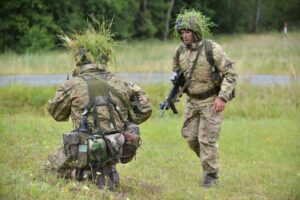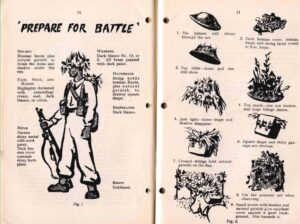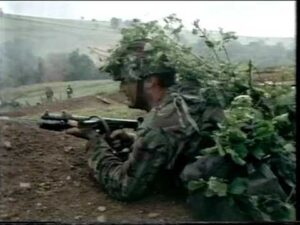One of my readers/sponsors has reminded me that it has been a while since I wrote about camouflage. As it turns out, I have a few thoughts to share.
A mnemonic often taught is the “Five S’s of Camouflage”. These are usually Shape, Shine, Shadow, Silhouette and Spacing. There are variations on this, some schemes adding extra factors. These may include Smell, Speed, Sound, Skyline and Smoking. Some even fly in the face of alliteration and suggest “Movement” and “Aircraft!”
Skyline can be considered an element of Silhouette. Smell is something that is sometimes neglected. A human’s sense of smell may be inferior to that of many animals but can still prove useful if the brain interprets to significance of a familiar or out of place odour.
Sound is not just obvious things like talking or gunfire. One of the reasons for the ninja covering his face was to muffle the sound of his breathing if he had exerted himself. The noise of chewing gum or tobacco may tip off an attentive enemy or prey. Give up both habits. Smoking is another habit to drop. As well as being an aiming point and location signal at night the smell of the smoke and on your clothes may give you away. Many smokers are litterbugs and a discarded cigarette butt can tell a competent tracker many things.
Shade/Shadow is something I found myself considering the other night while watching a movie . A cowboy rides ahead of a posse to scout a valley. He really should not ride straight down the middle like that, I thought. He could have easily swung into the big patch of shadow cast by the cliff on one side.
Shadows in your environment can be very useful. If you have to cross a forest road follow the shadow cast by a tree. You may be under aerial observation. If you are attempting to conceal something the shadows cast may negate your efforts. Remember that the angle and direction of light will vary with time.
Another factor to consider is texture, or in keeping with the theme “Surface”. This is an element that seems to be often neglected these days. You can paint your vehicle in different colours but it will still be an object with many flat, smooth surfaces, most of them vertical or horizontal.
Back when camouflage was taken more seriously I can recall Land Rovers covered in nets and hessian, sometimes looking like mobile blocks of heather. They still looked a bit boxy but viewed from the air they could easily be overlooked if they were static and positioned irregularly. You can still see similar examples, although oddly this seems more common on soft-skins than on actual fighting vehicles. Stowing gear under the nets can make the vehicle shape less regular. This is a variation of the old idea of placing balls of grass under a helmet net.
Surface is also the problem with most modern camouflage clothing. As has been discussed elsewhere, many current patterns lack the element size and contrast to disrupt body shape. Even when this is not the case the garments conform to the easily recognized shape of the human body. Smooth surfaces are not that common in nature. A good camouflage pattern is only the foundation upon which personal camouflage is built. Let me provide some illustrations:


These US troops are fairly typical. A patterned cloth cover does not camouflage a helmet, it remains a distinctive shape. No attempt has been made to paint or cover the distinctive black NVG brackets. These could at least be made in brown. Breaking up the shape of the helmet is perhaps moot when you have an uncamouflaged rosy-pink face beneath it. Note that none of these individuals have scarves they could use to veil their faces or make the head and neck area less distinctive. Other clothing has no attempts at shape disruption. If it was looser it would be more comfortable, better ventilated and more irregular in shape. Troops need a smock that fits over body armour and trousers that fit over the outside of knee-pads. Also note that there are not even temporary measures to conceal the distinctive shape of their weapons.




Next are two photos of British troops. These guys have camouflaged their helmets. One pair has used natural materials from their surroundings, the other appear to have used artificial materials (“textilage”). But they have stopped there. No materials added to the webbing, packs or pouches to break up their regular shape. No textilage added to the upper arms and shoulders to break up the shape. This would have also broken up the smooth appearance of their clothing, which takes us back to Surface.








Even if you are in a desert or urban environment with very little apparent vegetation, adding some texture to your helmet, clothing and gear can make you harder to see, and harder to target.
Personal camouflage is an important defence against snipers and observation.
Conventional forces assume they will always enjoy air superiority, but modern technologies such as drones may negate this on a local level.